

EXPLORE BY TOPIC:
  Our top 10 resources
Our top 10 resources
  Childhood / Early Life
Childhood / Early Life
  Chronic Stress
Chronic Stress
  Education
Education
  Food Security
Food Security
  Genetics
Genetics
  Jobs & Work
Jobs & Work
  Housing / Neighborhoods
Housing / Neighborhoods
  Income & Wealth
Income & Wealth
  Race / Racism
Race / Racism
  Social Inclusion
Social Inclusion
  Policy & Change
Policy & Change





Buy the DVD
e-Newsletter
FAQs
Contact Us
Site Map
Home

|
 |


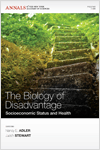 Multiple risk exposure as a potential explanatory mechanism for the socioeconomic status–health gradient Multiple risk exposure as a potential explanatory mechanism for the socioeconomic status–health gradient 
Gary W. Evans and Pilyoung Kim One potential underlying explanation for socioeconomic status (SES) gradients in health is exposure to multiple risk factors. Income and class tend to sort
individuals into different settings that are often accompanied by systematic differences in environmental quality. Housing and neighborhood quality, pollutants and toxins, crowding and congestion, and noise exposure all vary with SES. Persons lower in SES also iwc replica experience more adverse interpersonal relationships with family members, friends, supervisors, and communitymembers. Furthermore, exposure to thesemultiple risk factors is associated with worse health outcomes. Thus, the convergence of exposure tomultiple physical and psychosocial risk factors accompanying disadvantage may account for a portion of SES gradients in health in both childhood and adulthood. |
 |
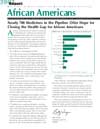 Nearly 700 Medicines in the Pipeline Offer Hope for Closing the Health Gap for African Americans (pdf) Nearly 700 Medicines in the Pipeline Offer Hope for Closing the Health Gap for African Americans (pdf) 
REPORT from the Pharmaceutical Research and Manufacturers of America, 2007 This publication from the Pharmaceutical Research and Manufacturers of America lists 691 medicines in development specifically for the African American population |
 |
 Neighborhood Characteristics Associated with the Location of Food Stores and Food Service Places Neighborhood Characteristics Associated with the Location of Food Stores and Food Service Places 
SCHOLARLY ARTICLE by Kimberly Morland, et al. American Journal of Preventative Medicine This study examines the distribution of food stores and food service places by neighborhood wealth and racial segregation. It finds that, compared to the poorest neighborhoods, large numbers of supermarkets and gas stations with convenience stores are located in wealthier neighborhoods. There are three times fewer places to consume alcoholic beverages in the wealthiest compared to the poorest neighborhoods. Regarding neighborhood segregation, there are 4 times more supermarkets located in white neighborhoods compared to black neighborhoods.
|
 |
 Neighborhood of Residence and Incidence of Coronary Heart Disease Neighborhood of Residence and Incidence of Coronary Heart Disease 
SCHOLARLY ARTICLE, Ana Diez-Roux, et al, 2001 A peer-reviewed study finding that even after controlling for personal income, education, and occupation, living in a disadvantaged neighborhood is associated with an increased incidence of coronary heart disease. |
 |
 Neighborhoods and health Neighborhoods and health 
Ana V. Diez Roux and Christina Mair This piece summarizes key work in the study of neighborhood health effects with a particular focus on chronic disease outcomes (specifically obesity and related risk factors) and mental health (specifically depression and depressive symptoms). Empirical work is classified into two main eras: studies that use census proxies and studies that directlymeasure neighborhood attributes using a variety of approaches. Key conceptual and methodological challenges in studying neighborhood health effects are reviewed. Existing gaps in knowledge and promising new directions in the field are highlighted.fausse sacoche de luxe |
 |
 Neuroscience, Molecular Biology, and the Childhood Roots of Health Disparities: Building a New Framework for Health Promotion and Disease Prevention Neuroscience, Molecular Biology, and the Childhood Roots of Health Disparities: Building a New Framework for Health Promotion and Disease Prevention 
SCHOLARLY ARTICLE, Journal of the American Medical Association, June 3, 2009 This paper, co-authored by Drs. Jack P. Shonkoff, W. Thomas Boyce, and Bruce S. McEwen, illustrates that the origins of many adult diseases can be traced to negative experiences early in life, so confronting the causes of adversity before and shortly after birth may be a promising way to improve adult health and reduce premature deaths.
Summary of Essential Findings (pdf)
Q&A (pdf)
|
 |
 New, Homes, New Neighborhoods, New Schools: A Progress Report on the Baltimore Housing Mobility Program New, Homes, New Neighborhoods, New Schools: A Progress Report on the Baltimore Housing Mobility Program 
Poverty and Race Research Action Council This report describes and evaluates the ambitious voucher program that has enabled 1500 families living in highly segregated and disadvantaged Baltimore inner city neighborhoods to move to integrated, suburban "opportunity" neighborhoods. The initiative originated as a partial settlement of the public housing desegregation case, Thompson v. HUD and was launched in 2003. |
 |
 No Time to Be Sick: Why Everyone Suffers When Workers Don't Have Paid Sick Leave (pdf) No Time to Be Sick: Why Everyone Suffers When Workers Don't Have Paid Sick Leave (pdf) 
REPORT by Vicky Lovell, Ph.D., Institute for Women’s Policy Research, 2004 Paid sick leave gives workers an opportunity to regain their health, return to full productivity at work, and avoid spreading disease to their co-workers, all of which reduces employers’ overall absence expense. When used to care for sick children or dependent relatives, it helps recovery times and reduces job turnover of working parents. However, new analysis of data collected by the U.S. Bureau of Labor Statistics reveals the inadequacy of paid sick leave coverage: more than 59 million workers have no such leave. Even more—nearly 86 million—do not have paid sick leave to care for sick children. |
 |
 No Vacation Nation (pdf) No Vacation Nation (pdf) 
REPORT by Rebecca Ray and John Schmitt, Center for Economic and Policy Research, May 2007
This report reviews the most recently available data from a range of national and international sources on statutory requirements for paid leave and paid public holidays in 21 rich countries (16 European countries, Australia, Canada, Japan, New Zealand, and the United States). In addition to our finding that the United States is the only country in the group that does not require employers to provide paid leave, we also note that almost every other rich country has also established legal rights to paid public holidays over and above paid leave. |
 |
 Nobody's Talking About the Silver Bullet That Could Heal the Economy and Cure Most Social Ills Nobody's Talking About the Silver Bullet That Could Heal the Economy and Cure Most Social Ills 
REVIEW of The Spirit Level: Why More Equal Societies Almost Always Do Better This article summarizes some of the key points of The Spirit Level, making a case for making fairness and equity explicit policy objectives. Contains graphs on relative income inequality across countries, correlation between health and social problems and inequality, and levels of income inequality during American history. |
 |
 Obesity, diets, and social inequalities Obesity, diets, and social inequalities 
SCHOLARLY ARTICLE by Adam Drewnowski, Nutrition Reviews, April 2009 This economic analysis of obesity concludes that inequitable access to healthy foods is one mechanism by which socioeconomic factors influence the diet and health of a population. As incomes drop, energy-dense foods that are nutrient poor become the best way to provide daily calories at an affordable cost. By contrast, nutrient-rich foods and high-quality diets not only cost more but are consumed by more affluent groups. This article discusses obesity as an economic phenomenon. Obesity is the toxic consequence of economic insecurity and a failing economic environment.
|
 |
 Oprah's unhealthy mistake Oprah's unhealthy mistake 
EDITORIAL by Osagie K. Obasogie, Los Angeles Times, May 2007
Like a game of whack-a-mole, the "slavery hypothesis" of hypertension keeps popping up in the media, popular culture and even medical texts no matter how many times it is slammed down. It has come to rolex daytona replica symbolize the incessant way in which unfounded biological theories of racial difference continue to thrive despite significant evidence to the contrary.
|
 |
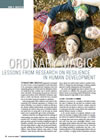 Ordinary Magic: Lessons From Research On Resilience In Human Development Ordinary Magic: Lessons From Research On Resilience In Human Development 
Canadian Education Association Resilience is all around us. Certainly as risk levels increase, the rates of resilience fall, and there are conditions under which no child can survive or flourish. However, early risk researchers did not expect to observe so much variation or so many good outcomes among children who experienced poverty, violence, disaster, or trauma.
This article will highlight key lessons learned from current research on resilience that may guide practices and policies aimed at promoting positive development among children exposed to high levels of risk or adversity. |
 |
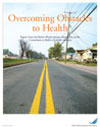 Overcoming Obstacles to Health Overcoming Obstacles to Health 
REPORT from the Robert Wood Johnson Foundation, 2013 This report by Paula Braveman and Susan Egerter for the Robert Wood Johnson Foundation Commission for a Healthier America, summarizes in clear language the current research on why Americans have worse health and shorter lives than people of other rich nations. The report analyzes the latest data and contains many useful charts.
|
 |
 Overview of Racial/Ethnic Disparities in Health (pdf) Overview of Racial/Ethnic Disparities in Health (pdf) 
PRESENTATION TRANSCRIPT, David Williams, 2004 A transcript of Williams's lecture at "Racial/Ethnic & Socioeconomic Disparities in Health: Implications for Action." He presents a clear overview of the association between race and ethnic status and how it combines with socioeconomic status to affect health. |
 |
 Overworked, Vacation-Starved America Ranks #1 in Depression, Mental Health Problems Overworked, Vacation-Starved America Ranks #1 in Depression, Mental Health Problems 
NEWS ARTICLE, In These Times, Nov 2008 Americans now work more hours than the citizens any other country, including Japan. According to a poll by Take Back Your Time, 52 percent of working Americans received less than a week of paid vacation in the past year – more than half of those received none – while 65 percent of workers received less than two paid weeks off. Pushing for guaranteed paid vacation could have major positive impacts on the nation's mental and physical health. |
 |
 Patterns and Causes of Disparities in Health (pdf) Patterns and Causes of Disparities in Health (pdf) 
ARTICLE by David Williams, Chapter in Policy Challenges in Modern Health Care This chapter provides an overview of social disparities in health in the United States. izmir escort It begins by outlining the complex social forces that combine to produce variations in health. It then considers the patterns of racial/ethnic differences in health and shows how these must be understood in the context of the heterogeneity of those groups, and the even larger disparities by socioeconomic status (SES) and gender. maltepe escort The chapter concludes by focusing on the opportunities and challenges for reducing social disparities in health in the United States.
Swiss automatic at affordable prices for men and women. sisli escort
|
 |
 Peaceful Revolution: The Last Summer (Without a Vacation) Peaceful Revolution: The Last Summer (Without a Vacation) 
EDITORIAL by John de Graaf in the Huffington Post, 2007 De Graaf comments on the findings of a recent ILO report that U.S. workers produce per capita wealth than any other country and are second most productive per hour in the world, yet more people are working longer hours just to make ends meet. After presenting statistics on how badly we compare to European countries on quality of life indicators, he makes the case for a federal mandate of three weeks paid vacation per year. |
 |
People in Poor Neighborhoods Breathe More Hazardous Particles 
Scientific American Tiny particles of air pollution contain more hazardous ingredients in non-white and low-income communities than in affluent white ones, a new study shows. |
 |
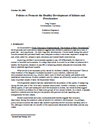 Policies to Promote the Healthy Development of Infants and Preschoolers Policies to Promote the Healthy Development of Infants and Preschoolers 
Greg Duncan and Katherine Magnuson What are the most important policy issues for children’s healthy development? There is clear evidence of the dangers of prenatal exposure to poor nutrition, infections and environmental neurotoxins (e.g., alcohol, lead), most of which are readily preventable with established interventions. Routine pediatric care for infants can effectively screen for and treat many important causes of early developmental delays. Recent experiments and many nonexperimental studies suggest that economic deprivation during the preschool years is harmful for children’s development. Accordingly, policy should minimize the chance that children experience severe economic hardship early in life, although it should also be mindful of the employment incentives that these policies may create. |
 |
 Politics and Health Politics and Health 
VIDEO PRESENTATION by Dennis Raphael, December 14, 2006 Dr. Raphael was part of a featured research symposium at the Center for Health Disparities in Cleveland, Ohio, that highlighted new information on the mechanisms of health disparities and interventions to reduce disparities.
Best UK Replica Watches Store: top fake watches uk
Buy Swiss Perfect Fake Breitling, Cartier, Omega cheap replica watches uk |
 |
 Poor education and early death Poor education and early death 
EDITORIAL in the San Francisco Chronicle, February 2006 An opinion piece discussing the importance of focusing on the relevance of good education for good health, based around a profile of Alameda County Health Officer Dr. Tony Iton - an expert featured in UNNATURAL CAUSES. |
 |
Poverty As A Childhood Disease 
Blog post by Dr. Perri Klass at the New York Times "Well" blog
"Think for a moment of poverty as a disease, thwarting growth and development, robbing children of the healthy, happy futures they might otherwise expect. In the exam room, we try to mitigate the pain and suffering that are its pernicious symptoms. But our patients’ well-being depends on more, on public health measures and prevention that lift the darkness so all children can grow toward the light." |
 |
 Presentation - The Unsolved Mystery of Racial Disparities in Birth Outcomes (pdf) Presentation - The Unsolved Mystery of Racial Disparities in Birth Outcomes (pdf) 
PRESENTATION SLIDES from Paula Braveman, MD, MPH, Professor of Family & Community Medicine and Director of the Center on Social Disparities in Health, University of California, San Francisco Dr. Braveman made this presentation, fully titled "The Unsolved Mystery of Racial Disparities in Birth Outcomes: Is Racism-Related Stress a Missing Part of the Puzzle?" at the NIH Summit on Health Disparities in December 2008. It provides an excellent summary of the logic and evidence that points to structural racism as a key factor in explaining the Black / white gap in infant mortality and low birth weight. Includes considerations of neighborhood, employment, social factors, the life-course model, and the "immigrant paradox."fausse sacoche de luxe |
 |
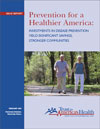 Prevention for a Healthier America: Investments in Disease Prevention Yield Significant Savings, Stronger Communities (pdf) Prevention for a Healthier America: Investments in Disease Prevention Yield Significant Savings, Stronger Communities (pdf) 
REPORT developed in a partnership of the Trust for America’s Health, The Urban Institute, The New York Academy of Medicine, the Robert Wood Johnson Foundation, The California Endowment, and Prevention Institute. Feb 2009
This study examines how much the country could save in health care costs if we invested more in disease prevention, specifically by funding proven community-based programs that result in increased levels of physical activity, improved nutrition (both quality and quantity of food), and a reduction in smoking and other tobacco use rates.bolsos imitacion |
 |
| « Prev 1 | 2 | 3 | 4 | 5 | 6 | 7 | 8 | 9 | 10 | 11 | 12 Next » |
|




